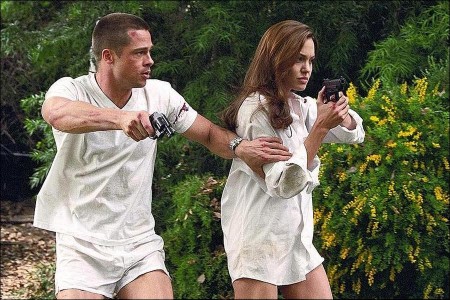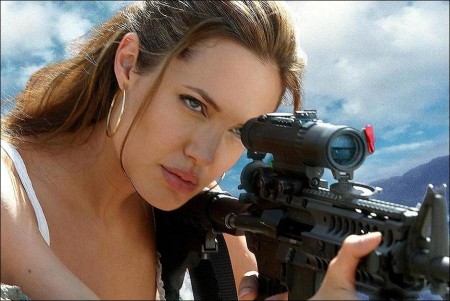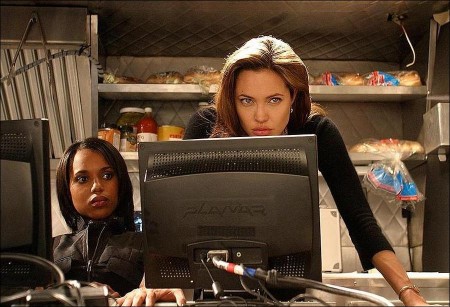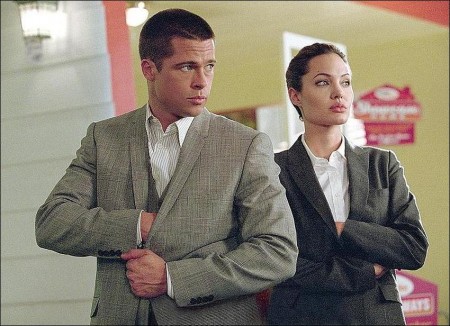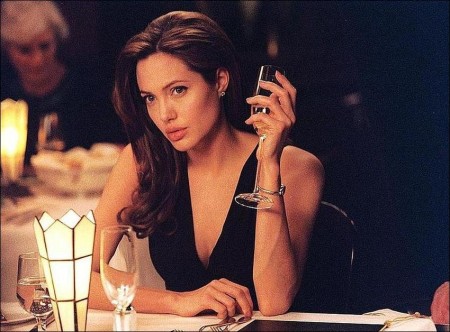John and Jane Smith are an ordinary suburban couple with an ordinary, lifeless suburban marriage. But each is hiding something the other would kill to know: Mr. and Mrs. Smith are actually highly paid, incredibly efficient assassins, and they work for competing organizations.
Mr. and Mrs. Smith discover a new source of excitement in their marriage, when they’re hired to assassinate each other…and that’s when the real fun starts. The result is the ultimate action spectacle, as Mr. and Mrs. Smith put their formidable skills to work and their marriage to the ultimate test.
Brad Pitt and Angelina Jolie star in Mr. and Mrs. Smith, a sexy action adventure, filled with globetrotting action, state-of-the-art special effects and incrediblestunts. It’s also a comedy with extraordinary characters having some ordinary problems. What became a big-event motion picture had somewhat modest origins.
Screenwriter Simon Kinberg wrote the first draft of the screenplay for his Master’s thesis at Columbia University Film School. “The idea came from my passion for Hong Kong action films,” says Kinberg, who went on to write or co-write XXX: State of the Union and X-Men 3. “The Hong Kong action films were cool, sleek, sexy and kinetic, and all that became the framework for my original draft.”
While Kinberg was brainstorming specific story ideas, he went to dinner with close friends who were experimenting with marriage therapy for the first time. “I was still trying to figure out the story,” says Kinberg, “when my friends told me about their experiences in marriage counseling. It sounded like a kind of mercenary experience, which I felt could be grafted on the skin of an action movie.”
With his first draft ready, Kinberg met with Akiva Goldsman, a noted screenwriter (he won the Oscar for his adaptation of A Beautiful Mind) and producer. The screenplay’s mix of action, adventure, romance, comedy and thrills impressed Goldman, who became a champion of the project.
“Mr. and Mrs. Smith is all about danger, sex and misunderstanding,” says Goldsman. “Rather than the traditional romantic comedy grammar, we have lots of action and bombs. But the action is secondary to character. The story is about a married couple being forced to hunt down and kill each other – and that forces them to pay attention to each other for first time in years. Learning the truth about one another, John and Jane Smith fall in love all over again.”
Goldsman and Kinberg shopped the script around, with little success at first. After Summit Entertainment and, eventually, Regency Enterprises, acquired the script, Brad Pitt came on board to star as John Smith. Before ‘Mrs. Smith’ was cast, the producers and Pitt handpicked Doug Liman to direct. Liman had proven himself capable of handling edgy fare, with Go, and big-scale action-adventure, with The Bourne Identity.
Liman was intrigued by the opportunity to make a film that pointed out that being a top assassin is easy compared with the rigors of keeping a marriage afloat. “My previous film, The Bourne Identity, celebrated Jason Bourne’s exceptional physical abilities,” says Liman. “So I was excited Mr. and Mrs. Smith gave me the chance to make a film that said, ‘Big deal, so you’re a highly-trained assassin. Try being married for six years; now that’s really impressive! “The film asks a question that is really fun to consider: How do assassins married to each other deal with their marital problems? Of course, the answer is, they try and kill each other.”
Liman, Pitt and the producers had been working on the film for several months when it came time to cast Pitt’s co-star. The role of Jane Smith necessitated a strong performer of equal talent. One of the industry’s most sought-after actresses, Angelina Jolie juggles a calendar booked months, sometimes years, in advance. Along with her acting commitments, she manages a full time schedule of duties as the High Commissioner for Refugees on behalf of the United Nations. Immediately following the completion of principal photography on Mr. and Mrs. Smith, the actress began filming a documentary, which she is financing herself, detailing the plight of refugees.
Fortunately for the film’s producers, an upcoming movie project fell apart at the last minute and Jolie was able to consider starring in Mr. and Mrs. Smith. Goldsman, along with Doug Liman and Lucas Foster, convinced Jolie that theirs was not a conventional action film.
“We spent time romancing Angie,” says Foster, “talking to her about our vision for the film, because it’s the sort of movie that walks a fine line in terms of tone and what it’s trying to accomplish. At the end of the day, it’s a relationship movie. It has that great push-pull of people who want to be together, but life and circumstance interferes, and yet somehow they have to work their way through it if they want to stay together.”
Jolie loved the film’s multiple tones. “There are dramatic scenes about relationship issues,” she notes, “and huge action sequences and fight scenes that push the envelope, and also there is real comedy. It’s a great balance and it’s perfect because it’s just like real life and marriage.”
Jolie also found several parallels with her on-screen alter ego. “I’m very much like Jane,” says Jolie. “I learned something about myself through playing her. It’s important for women to feel that they can be strong on their own, but it’s great to be involved with a film where a man and a woman need each other and are better when they’re together. There’s something great about people functioning as a team that movies haven’t focused on in a while.”
John and Jane’s secret lives don’t leave much room for friendships. The closest thing John has to a friend is a colleague, ‘Eddie.’ Eddie and John work in the same field but are very different in manner. “Brad and Angie worked from a very still and focused place, because they’re playing assassins,” says Akiva Goldsman. “‘Eddie’ is a different kind of assassin; he is frenetic and constantly arcing with energy. Throwing that into the John-Jane dynamic was a lot of fun.”
Like John, Jane’s circle of friends is limited. In fact, the closest thing she comes to a confidant is ‘Jasmine,’ played by Kerry Washington (Ray, Fantastic Four), a coworker who disapproves of Jane’s evolving relationship with John. “Jane doesn’t have real friends,” says Jolie. “She doesn’t allow herself to get close to anyone because that would make her vulnerable. For Jane, getting close to someone is the most dangerous thing in the world – and that’s saying a lot for a killer.”
Another pivotal character is Benjamin Danz, a low-level operative who figures in John and Jane’s ever-changing lives as assassins and as a married couple. Liman again turned to a former colleague, bringing aboard Adam Brody. Brody stars in “The O.C.,” which Liman executive produced during its first season.
Spy School
To bring the necessary verisimilitude to their portrayals of top assassins proficient in a multitude of firearms and deadly martial arts, Pitt and Jolie attended what the filmmakers describe as “spy school.” The two actors attended weekly gun-training sessions with Stunt Coordinators Mic Rodgers and Tim Trella, and Technical Advisor Mark Stefanich. A former member of S.E.A.L. Team Two as well as S.E.A.L. Team Six (also known as the Dev Group), Stefanich facilitated the actors’ training in special operations and counter-terrorism tactics.
“Brad and I have separately appeared in action films,” explains Jolie, “but that’s a specific method of training. I’ve never had a partner on film before and it’s very different working with one. We had to learn to move in tandem with fully loaded pump shotguns, crossing each other, running into houses, breaking and covering an area, shooting at moving targets – it was crazy, but we learned to trust each other.”
“We started them off with the basics, including weapons familiarization, proper stance, how to hold the weapon, safety and use,” Stefanich explains. “We progressed to moving through and shooting at multiple targets.”
Rather than training Pitt and Jolie as CIA operatives, Stefanich familiarized them with the training one gets in law enforcement or regular military groups, because time was of the essence. Training exercises took place over several weekends during production at Canyon Oaks, a private shooting range in Los Angeles’ San Fernando Valley.
By their very nature, covert operations are fluid and ever-changing, so the actors were taught to rely on their wits during much of the action. An operative must be ready to adapt to any circumstance, and change his or her tactics in the blink of an eye.
Pitt and Jolie were outfitted with the newest high tech weapons, including cuttingedge, non-lethal Taser and stun guns. The actors completed weapons indoctrination on a wide range of artillery, from the MP5 submachine gun to sophisticated pistols with aim points, optics and high capacity magazines. Prior to working with Stefanich, Pitt and Jolie selected their own weapons with one of the film’s Property Masters, Gary Tuers.
According to Stefanich, the actors were strict about not wanting to turn the action into fantasy. “They learned on the firing range how difficult it really is to become proficient with a firearm; how you can’t shoot from the hip and hit targets unless you happen to be a world champion shooter.”
Second Unit Director / Stunt Coordinator Simon Crane agrees. “The actors needed to learn a variety of the skills, such as weapons, firing rockets, driving cord bikes, and rock climbing. And to make it all look real, Brad and Angie constantly had to absorb new skills, and look like they’d been doing the tasks for years. There were lots of rehearsals.
“An audience wants to see the actors do their own stunts,” Crane continues. “They don’t want to see CG. People want to go to movies to be entertained by their favorite actors. I’d rather spend time rehearsing, testing, making it safe for the actors and then putting them in situations that look precarious.”
Action!
Even before detailing his characters, screenwriter Simon Kinberg structured the story around the action sequences, finding parallels between the action and the process of constructing a successful marriage.
The film’s action, comedy and romance involve not only gunplay, but, of all things, dance. Inspired by the ballet-like grace of Hong Kong action films, Kinberg’s ideas for the script were more akin to those in a traditional musical than the traditional action movie. “The action had to be big and fun, and play like an exploration of character,” explains Kinberg. “In a musical when the characters’ interaction encounters conflict or their love or excitement hits a fever pitch that they can’t express with normal dialogue, they break into song. John and Jane break into gunplay or a chase sequence, which is an expression of where their characters are in the context of their relationship.”
To Doug Liman, whose taut action scenes in The Bourne Identity set a new standard for cinema spy adventure, the Mr. and Mrs. Smith dance sequences were even more challenging than its large-scale action set pieces. “Directing the scenes of John and Jane Smith dancing scared me more than any other – and that’s saying a lot because this was a logistically complicated shoot,” notes Liman. “The dance scenes are some of the most romantic – and exciting – work I’ve ever put on film.”
John and Jane Smith first meet in Bogota, Colombia, where amidst a fiery revolution, they ignite in a dance marked by adrenaline, attraction and mystery. Renowned choreographer Marguerite Derricks worked with Pitt and Jolie to make them look as graceful and fluid as possible.
“The first time John and Jane dance, they are both leading,” says Kinberg. “Sometimes he leads, sometimes she leads; they’re competing. It’s a bit anonymous. The characters are a little drunk; they don’t know who the other person is and the excitement and energy of the space informs the dance.”
After they’re married, the Smiths soon learn there are no accidents when it comes to love. The couple continues a ridiculous charade, leading to marital tedium. Once their covers are blown, the Smiths discover that no marriage can survive without love and trust – and a clear picture of what one’s spouse does for a living.
But first, they play a dangerous cat-and-mouse game, culminating in an explosive fight – a “dance of death” – inside their suburban home. Their battle royale transitions from fighting to lovemaking, from wanting to kill each other, to finally discovering their real passion for each other.
“The scene is a cathartic release of energy that’s been stored up over the course of their hunt to kill one another,” says Kinberg. “John and Jane actually start to fall in love again because they’re paying attention – really paying attention – to each other for the first time. Their lies are being stripped away.
“When their secrets are exposed,” Liman says, “they are liberated and at the same time, vulnerable. Ironically, from that moment forward, the movie becomes about the characters feeling safer, even as life becomes more and more dangerous.”
Not technically a dance number, another big action sequence in the third act was nonetheless the most choreographed of the entire film. The sequence unfolds, then explodes, at a fictitious home improvement store. The production moved into a vacant IKEA warehouse in Torrance, California for the three weeks it took to shoot the scene.
Doug Liman and Simon Crane attacked this crucial action sequence with a vengeance. “We combined a mixture of styles for each character for the finale,” says Crane. “It looks like John makes up his plan of action as he goes along, but Jane is more succinct and very direct in her approach. Jane uses a sniper rifle whereas John is blasting away as he moves around. We had to come up with comedy beats within the scene and still make them look like killers.”
Adds Liman: “Our philosophy was that up to this point the Smiths were having problems working together, but now they’ve solved many of their underlying issues and are learning to work together. It was fun to watch them work as partners, like a smooth machine.”
Designing the Smiths’ World
The Smiths’ life as a couple is clouded by secrecy, lies, and ennui. This is reflected in, among other things, their home, which symbolizes their dying relationship. It is a space overflowing with creature comforts, exemplifying the height of style but with no real warmth and heart or soul. Theirs is a house, not a home.
“Their surroundings keep them from really experiencing each other,” says Akiva Goldsman. “It’s their beautiful, gilded cage.”
“Where they make their home is very rich, sophisticated and high concept,” describes Production Designer Jeff Mann. “In a nutshell, it’s the old adage that money cannot buy happiness, even within the confines of this beautiful environment. But the house still needed to be a reflection of who they are.”
Brad Pitt was particularly fascinated with the design of the Smith domicile, and he invited Mann, with whom he had worked on the film Kalifornia, to his home to discuss concepts. Mann was aware of Pitt’s longtime interest in art and design and took his style cues from the actor.
“Looking at Brad’s home was a great opportunity to see what he liked and what would help him step into his character,” says Mann. “I listened carefully to his ideas and then we embellished them for the film. Our discussions led to some interesting changes in the set design.”
Of course, since John and Jane are assassins, the house holds many secrets. John’s innocent-looking tool shed, for example, opens to reveal a cellar-sized supply room containing stacks of cash, plus rocket launchers, grenades, and dozens of different handguns. Jane’s oven, too, is a secret repository of high-tech weaponry. The twist is that neither Jane nor John is aware of the other’s covert stashes…until their fateful showdown inside the home.
The film’s look and action set pieces, as impressive as they are, always served the story. The two protagonists may be highly trained assassins, but in the end they have the same problems faced by many married couples: boredom, lies and soul-deadening routine. “In a way,” says Doug Liman, “we’re taking two people capable of near superhuman feats, and dropping them in the middle of suburbia, making them face the same type problems you and I face every day.
“In the end,” he concludes, “Mr. and Mrs. Smith is a spectacle that riffs on something we all struggle with, which is living with another human being.”
These production notes provided by 20th Century Fox.
Mr. and Mrs. Smith
Starring: Angelina Jolie, Brad Pitt, Adam Brody, Vince Vaughn, Kerry Washington, Michelle Monaghan, Rachel Huntley, Stephanie March
Directed by: Doug Liman
Screenplay by: Simon Kinberg, Jez Butterworth, John Henry Butterworth
Release Date: June 10th, 2005
MPAA Rating: PG-13 for violence, intense action, sexual content, strong language.
Studio: 20th Century Fox
Box Office Totals
Domestic: $186,336,279 (39.0%)
Foreign: $291,871,241 (61.0%)
Total: $478,207,520 (Worldwide)
